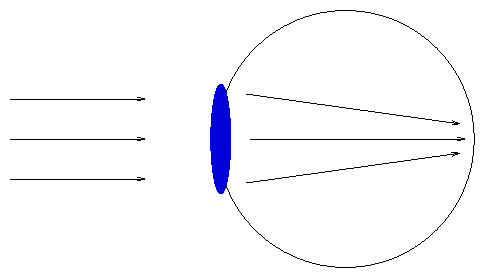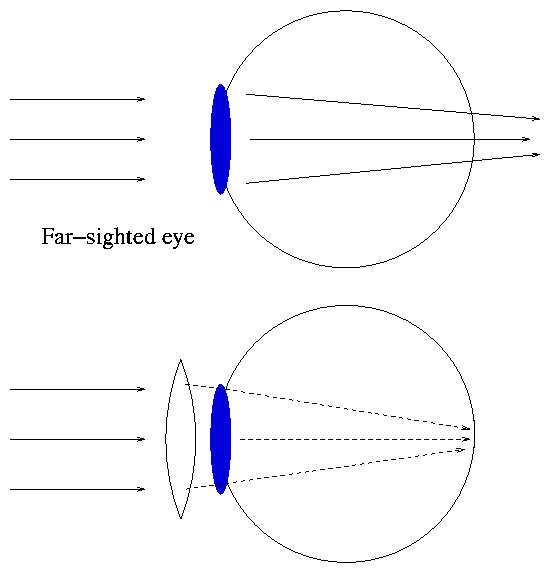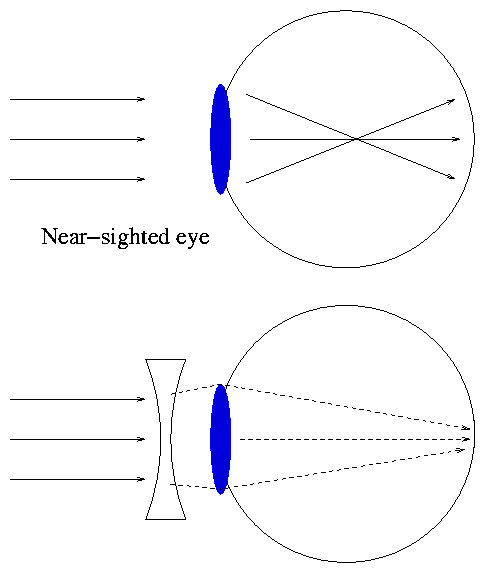
| MadSci Network: Physics |
What happens to light when it passes through eyeglasses? Hmmm. Let me start by explaining why some people need to wear glasses. When light enters your eye, it passes through a patch of clear tissue called the lens, which has a somewhat curved surface. The lens bends the light so that -- if all goes well -- the light comes to a surface on the light-sensitive cells of the retina, on the back wall of the eyeball. It should work like this:

Some people have lenses which aren't curved quite enough to bend the light so that it reaches a focus on the retina; instead, the light would come to a focus further into the head, beyond the boundaries of the eye. We call these people "far-sighted", because, although they see all objects as somewhat blurry, objects which are distant look the least blurry.

Far-sighted people need to wear eyeglasses which have convex lenses: pieces of glass which are thick in the middle and thin near the edges. Convex lenses help to bend the light before it reaches the eye's own lens, so that it already is starting to focus when it enters the eye.
Other people have lenses which are TOO strong: the light rays come to a focus in the middle of the eyeball, before they reach the retina on the back wall. We call these people "near-sighted", because, even though they see everything as blurry, objects which are close to their eyes look the sharpest.

Near-sighted people (like me) have to wear eyeglasses which have concave lenses: thin in the middle and thicker near the edges. These lenses spread light rays out before they enter the eye, so that the strong natural lens brings them to a focus at the proper location.
Okay so far?
Now, you ask in particular, "does the prescription affect the intensity of the light which passes through the eyeglasses?" Yes, it does, in an obvious way, and in a second, less obvious manner.
First, convex lenses -- the ones which are thicker in the middle -- bring all the light which passes through them together, so that it reaches a focus on the other side. Because they bend the light rays together, a bundle of light which passes through the lens will shrink into a narrower and narrower bundle on the far side, until all the rays come together at a single spot (the focal point). If you look at the rays near the focal point, you'll see many rays all bunched together; that means the intensity of the light will be higher than when it entered. The stronger the prescription, the more quickly the light rays will come to a focus after they pass through the lens.
Concave lenses, on the other hand, such as I wear, bend the light which passes through them so that it spreads out on the other side. The rays will never come together, only separate farther and farther apart as they move away from the eyeglasses. That means that the intensity will decrease after light passes through the eyeglasses.
You can make a simple check to see if any pair of eyeglasses is concave or convex. Hold the glasses close to a surface, so that rays from a distant light source (a light bulb several meters away, or the Sun, or a flashlight) pass through the lenses and fall onto the surface. You should see a faint shadow of the eyeglass frames. If the surface inside this shadow is BRIGHTER than the surroundings, it means that the eyeglasses are focusing light rays together; thus, the lenses are convex, and appropriate for a far-sighted person. If the surface is DARKER than the surroundings, it means that the eyeglasses are concave, and thus designed for a near-sighted person.
Now, the second effect: no glass is perfectly transparent. Some of the light rays which enter a pair of eyeglasses will be absorbed or scattered by the glass, so the total number of rays coming out the far side will always be slightly smaller than the number which came into the glass. The stronger the prescription, the thicker the glass of the lenses -- and thus the more light which is lost as it passes through.
Try the links in the MadSci Library for more information on Physics.